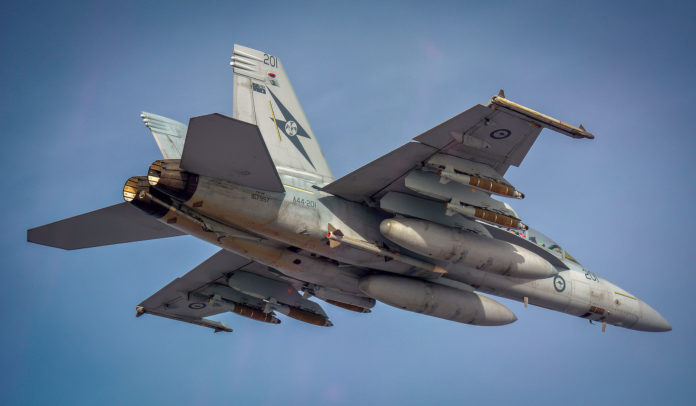Any discussion of the Air Power capability resident at RAAF Base Amberley has to include the performance of the two Super Hornet variants: the F/A-18F Super Hornet and the EA-18G ‘Growler’ electronic attack aircraft.
The Super Hornets of No 1 Squadron have proved their combat capability in the skies over the Middle East area of operations, conducting air strikes against the forces of Daesh.
No 1 Squadron is the sole operator of the F/A-18F variant in Australia, since No 6 Squadron re-equipped with the EA-18G ‘Growler’.
While regarded initially as filling a capability gap – with the retirement of the F-111, phasing out of the F/A-18A/B ‘Classic’ Hornets and introducing the F-35A Joint Strike Fighter into RAAF service – the Super Hornet has established an important place in the ADF’s Order of Battle. The introduction of the EA-18G ‘Growler’ has firmed the Super Hornet’s place in Australia’s combat air capability.


The RAAF bought 12 Growlers, which are highly modified Super Hornet airframes. When fully operational, Australia will have the only tactical Airborne Electronic Attack Capability in the world, outside of the United States.


In RAAF service the Growlers will work with other Defence Force assets such as the Navy’s new Air Warfare Destroyers and the Army’s combat units to identify, jam and when necessary, destroy enemy radar and communications systems.
Electronic Attack (EA) is the offensive suppression of an adversary’s electromagnetic spectrum, primarily radar and communications systems. In today’s technologically dependent air combat environment, denial of those systems would seriously impede an adversary’s ability to function effectively.
The EA-18G is capable of surviving in a high threat environment. Growlers aim to roll back the adversary’s air defenses through Suppression of Enemy Air Defence (SEAD) – firing the AGM-88 High-Speed Anti-Radiation Missiles at emitting enemy radars), airspace dominance, and rapid reaction support (jamming).
In an air combat situation, the enemy’s early warning systems provide tracking info to targeting systems, and they pass this information down to the shooters (defending aircraft and ground-based missiles primarily). If this information pathway is interrupted by EW, target engagement becomes far more difficult.
The combination of the F/A-18F and EA-18G variants of the Super Hornet therefore present a formidable air power capability for Australia, a capability that works seamlessly with the F-35A stealth fighter. RAAF Amberley may yet be home to a squadron of F-35 fighters.
Global airlift and air refueling
Now a familiar sight over Ipswich, the massive C-17A ‘Globemaster III’ arrived in 2006, first with four aircraft, then six and finally eight aircraft assigned to No 36 Squadron.
The RAAF also has a significant operational support capability with the KC-30A Multi-Role Tanker Transport aircraft assigned to No 33 Squadron. Both squadrons home-base at RAAF Amberley but operate on the global stage.
Extended operations in the Middle East and on Australian and international exercises have proved the worth of these air transport and air refuelling platforms in support of operations.
The C-17 provides unprecedented capacity for strategic airlift. It allows Australia to rapidly deploy troops, supplies, combat vehicles, heavy equipment and helicopters anywhere in the world.
These massive airlifters provide the logistics backbone for ADF operations at home and while deployed overseas. C-17As have also been an integral part of disaster relief and humanitarian missions worldwide.a
The C-17 is fitted with a cargo bay ramp that allows it to airdrop cargo in-flight, and can operate from unsurfaced runways as short as 3500 feet.
Able to carry up to 77 tonnes of cargo, the C-17’s cargo bay can accommodate loads ranging from: an Abrams Tank, four Bushmaster vehicles, or three helicopters. It can also be converted for the medical evacuation role. The C-17A can be refuelled in-flight by the KC-30A, extending its range further.
The KC-30A Multi Role Tanker Transport is a heavily modified Airbus A330 airliner, enabling Air Force to conduct air-to-air refuelling and provide strategic air lift. The KC-30 features advanced avionics systems, and an electronic warfare self-protection system for shielding against threats from surface-to-air missiles.


The KC-30A MRTT is fitted with two forms of air refuelling systems: an Advanced Refuelling Boom System mounted on the tail of the aircraft; and a pair of all-electric refuelling pods under each wing.
These systems are controlled by an Air Refuelling Operator in the cockpit, who can view refuelling on 2D and 3D screens.
The KC-30A carries a fuel load of more than 100 tonnes, and can transfer part of that load to compatible aircraft, including: F/A-18A/B Hornets; F/A-18F Super Hornets; E/A-18G Growlers; E-7A Wedgetails; C-17A Globemaster III; and other KC-30As, P-8A Poseidon surveillance aircraft, F-35A Lightning II, and allied aircraft.
In its transport role, the KC-30A can carry 270 passengers and its under-floor cargo compartments can accommodate 34,000 kilograms of military and civilian cargo pallets and containers.
The newest airlifter in the fleet is the C-27J ‘Spartan’ tactical tranport aircraft that replaced the venerable Caribou aircraft that served the RAAF for decades.
The C-27J Spartan battlefield airlifter will complement the Australian Defence Force’s existing air mobility fleet. Its capabilities bridge the gap between Army helicopters, such as the CH-47F Chinook, and larger Air Force aircraft, such as the C-130J Hercules and C-17A Globemaster III. It can operate from unsurfaced airstrips, and support humanitarian missions in remote locations.
These three aircraft types provide the transport and air refuelling support that is essential to support of air combat operations.



















![[CLOSED]December Mega Book Giveaways](https://lifestyleqld.com.au/files/wp-content/uploads/2017/11/books-265x198.jpg)









